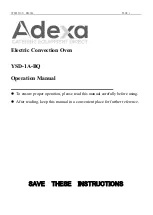
Tested for you in our cooking studio
en
47
Slow cook
Slow cooking is a technique for cooking food over a
long period at low temperatures. For this reason, it is
also called "low-temperature cooking".
Slow cooking is ideal for all prime cuts (e.g. tender
portions of beef, veal, pork, lamb or poultry) which are
to be cooked "à point". The meat will remain succulent
and tender.
The benefit of this cooking method is that it allows lots
of scope for menu planning because slow-cooked meat
is easy to keep warm. You do not have to turn the meat
when cooking. Keep the appliance door closed in order
to maintain an even cooking climate.
Only use fresh, clean and hygienic meat without bones.
Carefully remove sinews and fat from around the edge.
Fat develops a strong, distinct flavour during slow
cooking. You can also use seasoned or marinated
meat. Do not use defrosted meat.
Meat can be carved immediately following slow
cooking. No standing time is required. Due to the
special cooking method, the meat looks pink, but is not
raw or undercooked.
Note:
Delayed-start operation with an end time is not
possible for the slow cooking heating type.
Cookware
Use flat cookware, e.g. a glass/porcelain serving dish.
Place the cookware into the cooking compartment to
preheat it.
Always place the uncovered cookware onto the wire
rack at level 1.
You can find additional information in the tips on slow
cooking attached to the settings table.
Your appliance features the heating type "Slow cook".
Only start operation when the cooking compartment
has fully cooled down. Allow the cooking compartment
to warm up for around 10 minutes with the cookware
inside.
Sear the meat on the hotplate at a very high heat and
for a sufficiently long time on all sides, even on the
ends. Place into the preheated cookware right away.
Place the cookware containing the meat into the
cooking compartment once again and cook slowly.
Recommended setting values
The slow cooking temperature and cooking time are
dependent on the size, thickness and quality of the
meat. Different settings ranges are indicated for this
reason.
Type of heating used:
■
.
Slow cooking
Biscuits
With top/bottom heating at max. 190 °C.
With hot air at max. 170 °C.
Egg or egg yolk reduces the production of acrylamide.
Oven chips
Spread out a single layer evenly on the baking tray. Cook at least 400 g at once on a baking tray so that
the chips do not dry out.
Tips for keeping acrylamide to a minimum
Dish
Cookware
Shelf posi-
tion
Type of
heating
Searing time
in mins.
Tempera-
ture in °C
Cooking
time in
mins.
Poultry
Duck breast, 400 g
Cookware, uncovered
1
.
6-8
90*
45-60
Chicken breast fillet, 200 g each
Cookware, uncovered
1
.
5-7
90*
45-60
Turkey breast, boned, 1 kg
Cookware, uncovered
1
.
8-10
90*
120-150
Pork
Pork tenderloin steak, 5-6 cm thick,
1.5 kg
Cookware, uncovered
1
.
8-10
85*
210-240
Fillet of pork, whole
Cookware, uncovered
1
.
6-8
85*
60-90
Pork medallions, 4 cm thick
Cookware, uncovered
1
.
5-7
85*
90-120
Beef
Joint of beef (rump), 6-7 cm thick,
1.5 kg
Cookware, uncovered
1
.
8-10
85*
240-300
Beef tenderloin, whole, 1 kg
Cookware, uncovered
1
.
4-6
85*
120-180
Sirloin, 5-6 cm thick
Cookware, uncovered
1
.
6-8
85*
210-270
* Preheat
Summary of Contents for CM656GBS1
Page 1: ......
Page 3: ......
Page 56: ......
Page 57: ... 6 DXVJHUlWH PE DUO HU 6WU 0 QFKHQ 50 1 VLHPHQV KRPH FRP 9001093145 9001093145 950224 ...










































